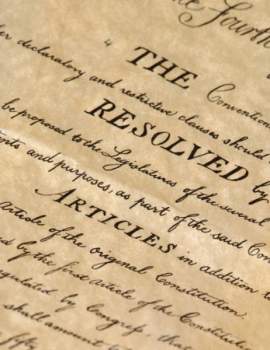
Means of Appointment and Voting Process in Congress

Popular In Constitution
Purpose Of Lifetime Appointment And Pros And Cons Enumerated Powers Bicameral Legislature Background Article 3 Of The Constitution We The People 1st Amendment Who Wrote The Constitution Judicial Review Three Fifths Compromise Equal Protection Clause 10th Amendment 5th Amendment
The selection and approval of Supreme Court nominees is intended to provide for the oversight of the institution as a whole by the other main branches of the Federal Government. The President makes the initial nomination of possible replacement for vacancies in the Supreme Court as a whole or the office of the Chief Justice, after which procedures are provided for Congress to approve or reject the Supreme Court nominees.
Until fairly recently in American history, the process of appointing and voting in Supreme Court nominees was not considered an aspect of the Government's operations likely to cause dissension, and as such, tended to occur quite quickly and without much supervision. The American scene of the preceding few decades, however, has seen an increasingly politicized atmosphere surrounding the Supreme Court and an increase in attention to the judicial leanings of Justices. As a result, the approval of Supreme Court nominees has become a far more closely monitored and difficult process.
The procedures for approving Supreme Court nominees is addressed in Article II of the Constitution, which gives the President the power to "appoint...judges of the Supreme Court" "with the Advice and Consent of the Senate." People who have previously served in lower courts or have in some other way distinguished themselves for legal knowledge or skill generally constitute the pool from which Supreme Court nominees are picked. However, it might be noted, if only as a point of interest, that the Constitution does not require any kind of legal fluency for Supreme Court nominees beyond that which is found by the President.
The responsible functioning of the nomination system is instead provided for by the allocation of decisive power to the Senate. If the Senate provides its approval, the President's next action is to draw up, sign, and place the Seal of the Department of Justice on a commission for the Supreme Court.
The means through which the Senate determines the acceptability of Supreme Court nominees has grown more rigorous over time. The modern American requirement for Supreme Court nominees to submit themselves to direct questioning by the Senate first appeared in 1925 and became established practice in 1955. These interviews are conducted by the Senate Judiciary Committee, which receives Presidential proposals for Supreme Court nominees and makes the decision on whether to submit them to the Senate as a whole for a vote.
The legislative tactic of a filibuster is not generally used for committee procedures, but it can be used to prevent a conclusive vote by the Senate on the candidate. The Senate vote is the last point for blocking the approval of Supreme Court nominees. The means for rejection of Supreme Court nominees include rejection by vote, taking no action, postponement of vote, the nominee's decision to decline the office, or the President's withdrawal of a nomination. As an example of the last possibility, which is usually undertaken when it becomes clear that political currents stand entirely against a nominee, last occurred when President George W. Bush withdrew Harriet Miers, his personal counsel, from consideration for the Supreme Court.
NEXT: What Is The Power of Impeachment




















